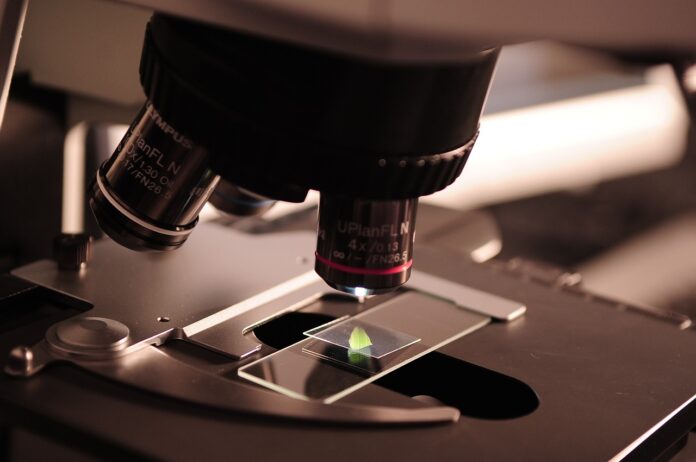Shortened insulin-like growth factor-1, or IGF-1 DES, is a splice variation. Studies suggest that several cell lines may be stimulated to hypertrophy and hyperplasia by IGF-1 DES, which is considered to be naturally present in the brain and uterine tissue. Studies have suggested that this protein variant might outperform conventional IGF-1 due to its possible increased bioavailability.
Irritable bowel disease (IBD), autism, and other neurological disorders are among those that researchers are investigating potential impacts following IGF-1 DES exposure. According to studies, it seems to aid in preserving central nervous system synaptic connections and, similar to other IGF-1s, may potentially stimulate the healing of connective and muscular tissues.
IGF-1 DES Peptide: Mechanism of Action
The N-terminal portion of the protein does not include the tripeptide Gly-Pro-Glu in IGF-1 DES, making it a shortened form of the original protein. The brain, cow colostrum, and pig uterine tissue have all been reported to have this naturally occurring form of IGF-1.
Since it is not bound to IGF-1 binding proteins, IGF-1 DES is more accessible and is believed to have ten times the potency of IGF-1 in promoting cell hypertrophy and proliferation. Research suggests the peptide may have potential as a research candidate in the context of inflammatory bowel disease and inducing anabolism in catabolic states (such as chronic sickness).
The exploration of IGF-1 DES in the context of various neurological and neurodevelopmental disorders has also garnered much attention. Scientists studying ASD have speculated that IGF-1 and similar substances might significantly impact the synaptic function of neurons.
Findings imply that several behavioral features of autism have been facilitated, and symptoms alleviated in animal models with IGF-1 DES and IGF-1.
IGF-1 DES vs. IGF-1: What is the Difference?
IGF-1 DES differs significantly due to omitting just three amino acids from its N-terminal terminus. According to studies, IGF-1 binding proteins (IGFBPs) are present in the blood and many tissues but do not bind well to IGF-1 DES. Because of this, IGF-1 DES is hypothesized to be more effective than IGF-1 alone (similar effects at lower concentrations) because a larger amount of the peptide may bind to key receptors.
According to studies conducted on pigs and marmosets, IGF-1 DES seems to have a two to three-times stronger blood sugar-lowering effect than IGF-1. Investigations purport that the same potency effects may be present in IGF-1’s other characteristics, including its neuroprotective and anabolic effects on skeletal muscle.
Reducing clearance from the circulation is one property of binding to IGFBPs, which prolongs action. Accordingly, compared to IGF-1, IGF-1 DES appears to have a much quicker start-up time, a greater peak activity, and a quicker withdrawal time.
Studies conducted on swine suggest that IGF-1 variations with lower affinity for IGFBPs may significantly impact growth. Even when caloric intake is severely restricted, IGF-1 DES has been theorized to have anabolic effects. The potential of IGF-1 DES on rats has been studied extensively, and it has been purported that as little as 14 days of presentation might lead to significant improvements in weight, nitrogen retention, and food conversion efficiency. This second information is crucial because IGF-1 DES may enhance anabolism despite low caloric intake.
This property might make the peptide an interesting exploration in research on chronic diseases. Findings imply that one additional property of IGF-1 is that it may lower blood sugar levels quickly after presentation, making it a more effective anti-hyperglycemic substance. This contributes to the peptide’s potential to increase growth while decreasing caloric intake.
IGF-1 DES Peptide and Neurological Research
Insulin-like growth factor 1 (IGF-1) has long been speculated to significantly affect neuronal proliferation, differentiation, and survival. Studies suggest this protein may be essential for learning, memory, and many other cognitive processes because of its alleged function in synapse development. It has been hypothesized that the formation and maintenance of mature synapses may rely heavily on IGF-1.
According to research, to get the correct amounts of presynaptic synapsin-1, a protein that controls the release of neurotransmitters, IGF-1 may be crucial. The post-synaptic PSD-95 protein, crucial in preserving synaptic structure, likewise relies on the peptide. Disruptions in synaptic formation and subsequent impairments in motor abilities, behavior, cognitive functioning, and language occur without IGF-1.
Rett syndrome and chromosome 22 deletion syndrome have been studied with IGF-1 and similar equivalents. Both instances suggest that the peptides seem helpful. How? By potentially keeping neuron density and the amount of excitatory synapses in the brain intact. Additionally, research has indicated that IGF-1 may mitigate the neurotoxic consequences of NDMA over-stimulation, shielding neurons against excitotoxicity—a condition that may result in neuronal death.
Research on the potential of IGF-1 on neurological disorders such as MS, ALS, PD, and AD has been inconclusive. For example, in amyotrophic lateral sclerosis (ALS), IGF-1 appeared to significantly slow disease progression and enhance muscular strength and respiratory function. For multiple sclerosis, the peptide was deemed essentially ineffective.
Further research is needed to learn more about these diseases and how IGF-1 DES may help. Since MS is mostly caused by damage to the cells surrounding neurons rather than neuronal death, the peptide’s ineffectiveness in the context of the disease is not unexpected. It has been hypothesized that researchers may learn more about the underlying pathophysiology of various diseases and disorders using IGF-1 DES and other IGF-1 analogs, which might lead to the development of new research compounds.
Click here if you are a researcher interested in buying high-quality IGF-1 DES for your scientific investigations. Please note that none of the substances mentioned in this article have been approved for human consumption and should, therefore, only be used by licensed professionals, academics, or scientists in the confinement of environments such as laboratories or research facilities. This article serves educational purposes only.
References
[i] F. J. Ballard, J. C. Wallace, G. L. Francis, L. C. Read, and F. M. Tomas, “Des(1-3)IGF-I: a truncated form of insulin-like growth factor-I,” Int. J. Biochem. Cell Biol., vol. 28, no. 10, pp. 1085–1087, Oct. 1996.
[ii] F. M. Tomas, P. E. Walton, F. R. Dunshea, and F. J. Ballard, “IGF-I variants which bind poorly to IGF-binding proteins show more potent and prolonged hypoglycaemic action than native IGF-I in pigs and marmoset monkeys,” J. Endocrinol., vol. 155, no. 2, pp. 377–386, Nov. 1997.
[iii] P. E. Walton, F. R. Dunshea, and F. J. Ballard, “In vivo actions of IGF analogues with poor affinities for IGFBPs: metabolic and growth effects in pigs of different ages and GH responsiveness,” Prog. Growth Factor Res., vol. 6, no. 2–4, pp. 385–395, 1995.
[iv] F. J. Ballard, P. E. Walton, S. Bastian, F. M. Tomas, J. C. Wallace, and G. L. Francis, “Effects of interactions between IGFBPs and IGFs on the plasma clearance and in vivo biological activities of IGFs and IGF analogs,” Growth Regul., vol. 3, no. 1, pp. 40–44, Mar. 1993.
[v] J. Costales and A. Kolevzon, “The Therapeutic Potential of Insulin-Like Growth Factor-1 in Central Nervous System Disorders,” Neurosci. Biobehav. Rev., vol. 63, pp. 207–222, Apr. 2016.
[vi] R. Riikonen, “Insulin-Like Growth Factors in the Pathogenesis of Neurological Diseases in Children,” Int. J. Mol. Sci., vol. 18, no. 10, Sep. 2017.
[vii] A. B. Steinmetz, S. A. Stern, A. S. Kohtz, G. Descalzi, and C. M. Alberini, “Insulin-Like Growth Factor II Targets the mTOR Pathway to Reverse Autism-Like Phenotypes in Mice,” J. Neurosci. Off. J. Soc. Neurosci., vol. 38, no. 4, pp. 1015–1029, 24 2018.
Write and Win: Participate in Creative writing Contest & International Essay Contest and win fabulous prizes.











